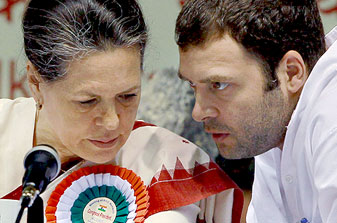 New Delhi, Feb 12: Congress president Sonia Gandhi has been made the Chairperson of the party's 50-member Campaign Committee for the 2014 Lok Sabha polls in which Rahul Gandhi will be the co-chairman, the party announced on Tuesday night.
New Delhi, Feb 12: Congress president Sonia Gandhi has been made the Chairperson of the party's 50-member Campaign Committee for the 2014 Lok Sabha polls in which Rahul Gandhi will be the co-chairman, the party announced on Tuesday night.
The announcement came less than a month after the Congress had said that Rahul, the party vice president, will lead its campaign in the upcoming general elections due in May.
The announcement regarding the posts to be held by Sonia and Rahul in the Committee was made in a statement released to the press by AICC General Secretary Janardan Dwivedi.
Prime Minister Manmohan Singh will be a member of the committee along with several union ministers.
Senior ministers AK Antony, P Chidambaram, Sushil Kumar Shinde, Ghulam Nabi Azad, Salman Khurshid, Kamal Nath, Anand Sharma and Jairam Ramesh; former CMs Sheila Dikshit and Ashok Gehlot and senior party leaders Ahmed Patel, Motilal Vora, Janardan Dwivedi, Madhusudan Mistri, Digvijay Singh, Ambika Soni and BK Hariprasad are among the members of the committee.
Union Ministers Jyotiraditya Scindia, V Narayanasamy, Jitender Singh, Rajeev Shukla, Manish Tewari and JD Seelam also figure in the list.
The Lok Sabha polls will most likely be held in the month of April and May and the new government is expected to be formed by the end of May.
The main Opposition, the Bharatiya Janata Party has declared Gujarat Chief Minister, Narendra Modi, as the party's prime ministerial candidate for the upcoming polls. The announcement was made by party president Rajnath Singh in September last year.
However, the Congress refrained from naming vice president Rahul Gandhi as its PM candidate, even though there was calmour amongst party's cadres to do so. Party leaders maintained that if the party
was in the position to form the government after the elections, then the elected MPs would decide as to who their PM would be.
Meanwhile, Modi has been traveling across the country, addressing rallies and taking on the Congress-led UPA government on the issues of non-governance and corruption. With the Congress hit by allegations of scams, price-rise, inflation and policy-paralysis, the BJP is hoping to ride on the wave of anti-incumbency and come back to power at the Centre after a decade. It is also hoping that the so-called Modi-wave will help them cross the finishing line and reach the magical figure of 271.





Comments
Add new comment